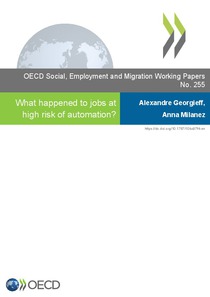What happened to jobs at high risk of automation?

Georgieff, Alexandre ; Milanez, Anna
Organisation for Economic Co-operation and Development, Paris
OECD Publishing - Paris
2021
67 p.
automation ; employment security ; epidemic disease
OECD Social, Employment and Migration Working Papers
255
Employment
https://doi.org/10.1787/10bc97f4-en
English
Bibliogr.
"This study looks at what happened to jobs at risk of automation over the past decade and across 21 countries. There is no support for net job destruction at the broad country level. All countries experienced employment growth over the past decade and countries that faced higher automation risk back in 2012 experienced higher employment growth over the subsequent period. At the occupational level, however, employment growth has been much lower in jobs at high risk of automation (6%) than in jobs at low risk (18%).
Low-educated workers were more concentrated in high-risk occupations in 2012 and have become even more concentrated in these occupations since then. In spite of this, the low growth in jobs in high-risk occupations has not led to a drop in the employment rate of low-educated workers relative to that of other education groups. This is largely because the number of low-educated workers has fallen in line with the demand for these workers.Going forward, however, the risk of automation is increasingly falling on low-educated workers and the COVID-19 crisis may have accelerated automation, as companies reduce reliance on human labour and contact between workers, or re-shore some production."
Digital
The ETUI is co-funded by the European Union. Views and opinions expressed are however those of the author(s) only and do not necessarily reflect those of the European Union or the ETUI.